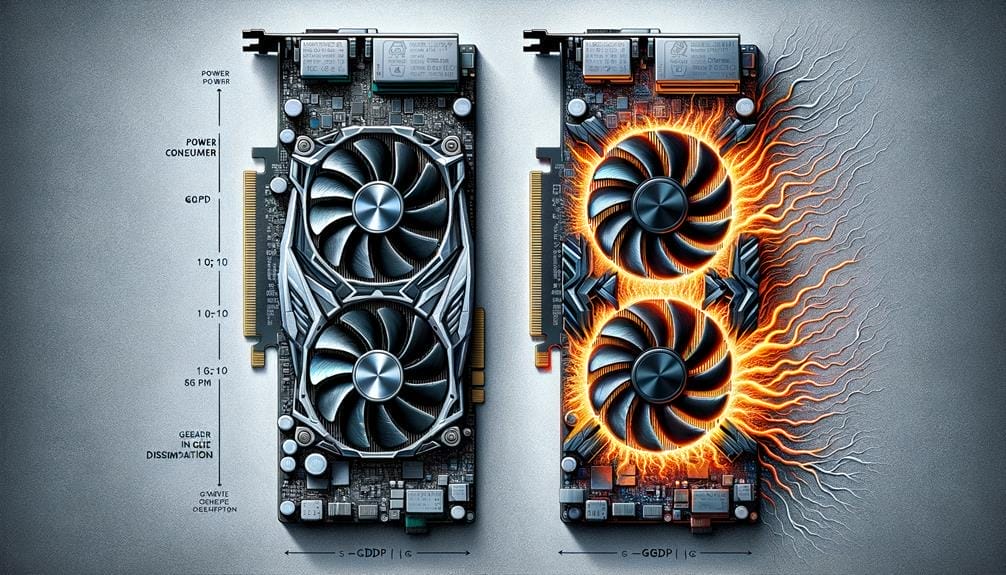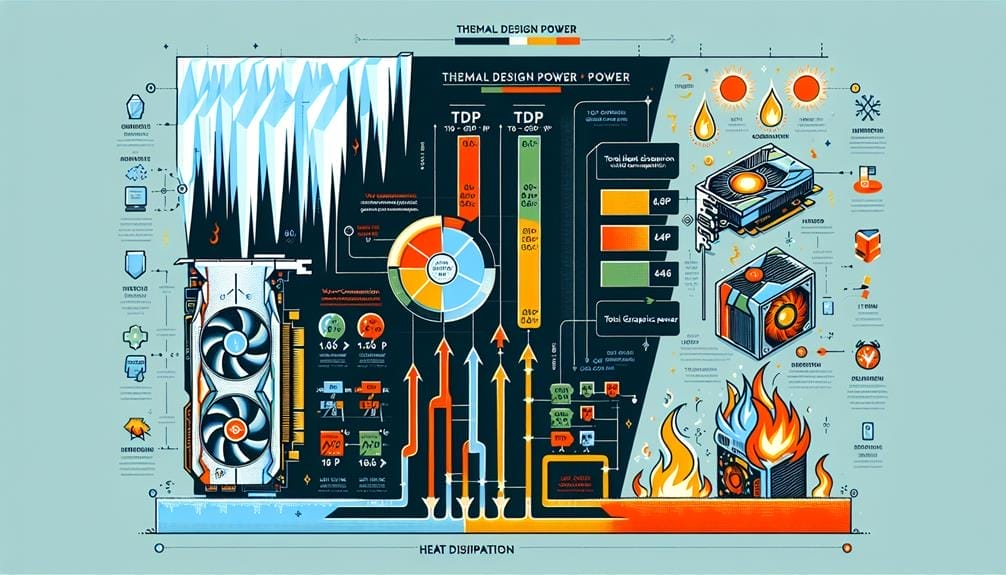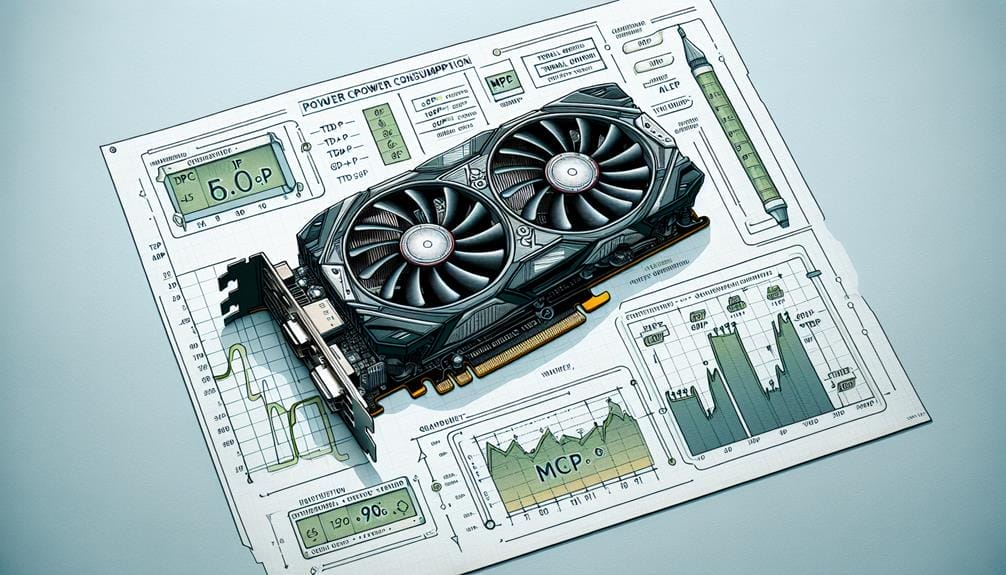Decoding Graphics Card Power: TDP Vs TGP

The growing fascination with advanced graphics cards has highlighted the need to understand their power consumption complexities. It’s now essential for both enthusiasts and professionals who are looking to boost their system’s performance to comprehend the difference between Thermal Design Power (TDP) and Total Graphics Power (TGP).
Understanding the implications of these power metrics extends beyond mere technicalities, influencing performance, cooling solutions, and hardware compatibility. As we unravel the complexities of TDP and TGP in the context of graphics card selection and operation, we aim to provide a comprehensive overview of the critical factors shaping this facet of GPU technology.
Key Takeaways
- TDP (Thermal Design Power) refers to the maximum intended wattage and heating of a graphics card component.
- TGP (Total Graphics Power) is a metric used to measure the entire graphics card's power utilization, including GPU TDP as well as power needed for fans, cooling, and lighting features.
- MPC (Max Power Consumption) is similar to TGP but includes a GPU's maximum power consumption in any condition, including overclocking.
- TDP and TGP are important specifications to consider when choosing a graphics card, as they indicate power consumption and heat output.
Understanding Graphics Card TDP

Understanding the intricacies of graphics card Thermal Design Power (TDP) is essential for making informed decisions about power supply requirements and cooling solutions when selecting a graphics card for a system build. TDP represents the maximum intended wattage and heat output of the GPU processing chip. Higher TDP indicates higher power consumption and heat generation, necessitating efficient cooling solutions.
It's crucial to explore cooling solutions to match the TDP of the selected graphics card, ensuring optimal performance and longevity. Additionally, higher TDP may require a higher grade of power supply to meet the demands of the graphics card. Therefore, understanding TDP is fundamental for system builders to select appropriate power supply units and cooling solutions, ensuring stable and efficient operation of the graphics card within the system.
Exploring Graphics Card TGP
Exploring the intricacies of Graphics Card TGP provides valuable insights into the comprehensive power utilization metrics essential for informed hardware selection and system optimization.
When evaluating TGP efficiency and considering the impact of TGP on power supply choice, several critical factors should be taken into account:
- Comprehensive Power Measurement: TGP encompasses not only the GPU TDP but also the power required for cooling, lighting, and other features, providing a more holistic view of power utilization.
- Aiding Power Supply Selection: Understanding a graphics card's TGP is crucial for selecting an adequate power supply, ensuring stable and efficient power delivery to the system.
- Optimizing System Performance: Properly evaluating TGP allows for the optimization of system performance by ensuring that the power supply can meet the card's demands without overloading or underperforming.
- Balancing Power Usage: Analyzing TGP helps in balancing power usage, preventing potential bottlenecks and ensuring the longevity of the hardware.
Delving Into Graphics Card MPC

Making informed hardware selections and optimizing system performance involves a comprehensive understanding of the power utilization metrics, including Graphics Card MPC, which provides crucial insights into the maximum power consumption of a GPU under various conditions.
Graphics Card MPC (Max Power Consumption) is a critical metric, especially in the context of overclocking implications and power supply requirements. When overclocking, the power consumption of the GPU increases, leading to a higher effective TDP. Therefore, high-quality power supplies are essential for stable operations during overclocking.
Additionally, maintaining efficient cooling becomes paramount to mitigate the heat generated from the increased power consumption. Understanding Graphics Card MPC is vital for users who seek to push the performance boundaries of their GPUs while ensuring the stability and longevity of their systems.
Comparing TDP and TGP Significance
The comparison between Thermal Design Power (TDP) and Total Graphics Power (TGP) is instrumental in evaluating the power utilization and heat management of graphics cards.
- Power Consumption: TDP focuses on the maximum intended wattage and heating of the GPU processing chip, while TGP encompasses the entire graphics card's power utilization, including cooling and lighting features.
- Cooling Requirements: TDP provides insights into the heat output of the GPU chip, aiding in evaluating cooling needs. On the other hand, TGP considers the overall power requirements for efficient cooling, including fans and other components.
- Performance and Cooling Trade-off: Higher TDP can indicate better performance but also necessitates enhanced cooling solutions, while TGP offers a comprehensive view of cooling requirements for the entire graphics card.
- Choosing Power Supply: Both TDP and TGP are crucial in determining the appropriate power supply for a graphics card, ensuring optimal performance and longevity.
Considering TDP and TGP for GPU Selection

With increasing emphasis on power utilization and heat management for graphics cards, the consideration of TDP and TGP becomes paramount when selecting a GPU for optimal performance and longevity. Evaluating the impact of TDP and TGP on graphics card performance is crucial, as higher TDP and TGP indicate increased power consumption and heat output, which can affect system stability and longevity.
Factors to consider when choosing a power supply for high TDP and TGP graphics cards include ensuring that the power supply can deliver the required wattage, and has the necessary connectors, such as dual 8-pin connectors for high TDP GPUs.
Additionally, efficient cooling solutions should be in place to manage the heat generated by high TDP and TGP graphics cards, ensuring reliable and consistent performance.
Accessing Additional Resources and Support
For those seeking further information and assistance regarding PC hardware, power delivery, or cooling, our CGDirector Team is readily available to provide expert support and guidance.
Here are some ways to access additional resources and support:
- Online Support: Visit our website for comprehensive articles, guides, and FAQs on PC hardware and cooling solutions.
- Expert Consultation: Schedule a consultation with our team to discuss specific hardware requirements and power delivery solutions tailored to your needs.
- Community Forum: Join our CGDirector Forum to engage in extended tech discussions with other experts and enthusiasts, sharing insights and seeking support.
- Newsletter Subscription: Subscribe to our newsletter for regular updates on the latest developments in PC hardware, power delivery, and cooling solutions.
Our goal is to empower you with the knowledge and support you need to make informed decisions and optimize your PC hardware setup.
Conclusion
In conclusion, the distinctions between Thermal Design Power (TDP) and Total Graphics Power (TGP) are crucial for understanding the power requirements and thermal considerations of graphics cards.
By unraveling the implications of TDP and TGP in relation to performance, cooling, and power supply compatibility, this discussion provides valuable insights for enthusiasts and professionals in navigating the diverse landscape of graphics card offerings.
Accessing additional resources and support can further enhance understanding and facilitate informed decision-making in harnessing the potential of graphics card power dynamics.

